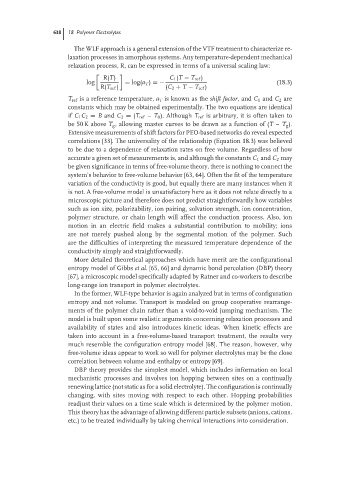Page 664 - Handbook of Battery Materials
P. 664
638 18 Polymer Electrolytes
The WLF approach is a general extension of the VTF treatment to characterize re-
laxation processes in amorphous systems. Any temperature-dependent mechanical
relaxation process, R, can be expressed in terms of a universal scaling law:
R(T) C 1 (T − T ref )
log = log(a T ) =− (18.3)
R(T ref ) (C 2 + T − T ref )
T ref is a reference temperature, a T is known as the shift factor, and C 1 and C 2 are
constants which may be obtained experimentally. The two equations are identical
if C 1 C 2 = B and C 2 = (T ref – T 0 ). Although T ref is arbitrary, it is often taken to
be 50 K above T g , allowing master curves to be drawn as a function of (T – T g ).
Extensive measurements of shift factors for PEO-based networks do reveal expected
correlations [33]. The universality of the relationship (Equation 18.3) was believed
to be due to a dependence of relaxation rates on free volume. Regardless of how
accurate a given set of measurements is, and although the constants C 1 and C 2 may
be given significance in terms of free-volume theory, there is nothing to connect the
system’s behavior to free-volume behavior [63, 64]. Often the fit of the temperature
variation of the conductivity is good, but equally there are many instances when it
is not. A free-volume model is unsatisfactory here as it does not relate directly to a
microscopic picture and therefore does not predict straightforwardly how variables
such as ion size, polarizability, ion pairing, solvation strength, ion concentration,
polymer structure, or chain length will affect the conduction process. Also, ion
motion in an electric field makes a substantial contribution to mobility; ions
are not merely pushed along by the segmental motion of the polymer. Such
are the difficulties of interpreting the measured temperature dependence of the
conductivity simply and straightforwardly.
More detailed theoretical approaches which have merit are the configurational
entropy model of Gibbs et al. [65, 66] and dynamic bond percolation (DBP) theory
[67], a microscopic model specifically adapted by Ratner and co-workers to describe
long-range ion transport in polymer electrolytes.
In the former, WLF-type behavior is again analyzed but in terms of configuration
entropy and not volume. Transport is modeled on group cooperative rearrange-
ments of the polymer chain rather than a void-to-void jumping mechanism. The
model is built upon some realistic arguments concerning relaxation processes and
availability of states and also introduces kinetic ideas. When kinetic effects are
taken into account in a free-volume-based transport treatment, the results very
much resemble the configuration entropy model [68]. The reason, however, why
free-volume ideas appear to work so well for polymer electrolytes may be the close
correlation between volume and enthalpy or entropy [69].
DBP theory provides the simplest model, which includes information on local
mechanistic processes and involves ion hopping between sites on a continually
renewing lattice (not static as for a solid electrolyte). The configuration is continually
changing, with sites moving with respect to each other. Hopping probabilities
readjust their values on a time scale which is determined by the polymer motion.
This theory has the advantage of allowing different particle subsets (anions, cations,
etc.) to be treated individually by taking chemical interactions into consideration.

